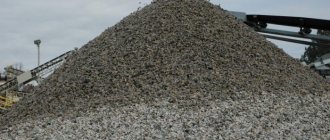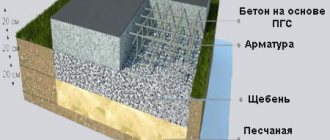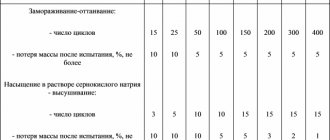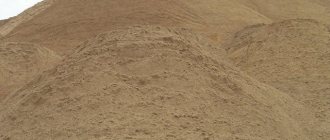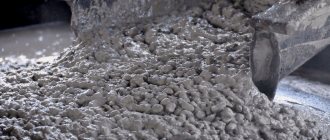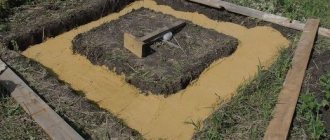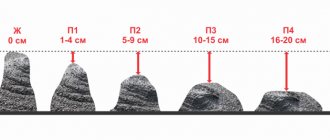Fraction
Crushed granite is the most common option because it has a high level of temperature resistance and practically does not absorb water. The strength of granite meets all technical requirements. The most popular fractions of granite:
- fine-grained – 5-15 mm;
Fraction 5-15
- small – 5-20 mm;
Fraction 5-20
- average small – 5-40 mm;
Fraction 5-40
- average – 20-40 mm;
Fraction 20-40
- large – 40-70 mm.
Fraction 40-70
Each type has different areas of application; the fine fraction of slag is mainly used for:
- formation of formwork, foundation;
Formation of the foundation
- preparation of ballast layers that are necessary for railway tracks and roads;
Railway embankment
- added to building mixtures.
Construction mixture
Based on what to choose relative compaction
The compaction coefficient strongly depends on various indicators and characteristics of the material; the following must be taken into account:
- average density, usually set by the manufacturer, but generally ranges from 1.4 to 3 g/cm³. This is one of the key parameters used in the calculations;
- flakiness to predict the plane of crushed stone;
- fractional sorting, smaller grain size – higher density;
- resistance of the material to frost depends on the breed;
- radioactivity of rubble. The first class can be used everywhere, and the second only for country roads.
ASG compaction coefficient
Sand-gravel mixture (SGS) is a natural or enriched (OPGS) mixture of sand and gravel. The composition of the natural mixture is standardized by GOST 23735-2014; according to GOST, the content of gravel grains with a fraction of about 5 mm should be within 10...90%.
This material is rarely used for filling a sand and gravel cushion under the foundation; it is more often used for the production of medium and heavy concrete. Accordingly, the grain size and percentage composition of the mixture greatly influence the compaction coefficient of concrete.
The ASG group must be taken into account according to the table.
Varieties and characteristics
Various types of crushed stone can be used for construction; the range today is quite large, but the properties also differ significantly.
Depending on the type of rock, the following main raw material groups :
- gravel;
- limestone;
- granite;
- secondary.
Granite rock is the strongest because it is the material that remains after the magma cools. Due to the high strength of the rock, it is difficult to process. Produced on the basis of GOST 8267-93.
Crushed stone 5-20 mm has become widespread, as it can be used for almost all types of construction.
Granite
The gravel variety is more free-flowing , and accordingly the compaction coefficient of crushed stone is higher. It is mined by grinding rocks, which makes it a cheaper material, but also less durable.
Methods for determining compaction coefficient
The compaction coefficient of the material is determined by the manufacturer and is indicated in the passport accompanying each batch. Often there is a need to determine the compaction coefficient of crushed stone during compaction and at the construction site. The measurement is carried out using a density meter, provided that the material contains no more than 15% of particles whose particle size exceeds 10 mm. The accuracy of determination is 90 - 100% of the standard density according to GOST.
The compaction of the material is determined by the resistivity readings when the tip is immersed - a regular or truncated cone, depending on the type of mixture. The indicator is determined by the deviation of the arrow of the device indicator.
The measurement is made by strictly vertically immersing the cone of the device into the mixture with the necessary pressure. Each point is measured 3-5 times with a distance of 150 mm between the immersion points. Next, the average value is determined from the obtained measurement results. Using the graph supplied with the device and the average data obtained, the compaction coefficient of crushed stone during compaction is determined.
The best option is to purchase crushed stone directly from the manufacturer, bypassing intermediaries. This is beneficial in terms of price, supply capabilities, quality, as well as the availability of all necessary documentation with crushed stone parameters based on laboratory research data.
Why know the compaction coefficient according to GOST
The compaction coefficient is regulated by SNIP, as well as GOST, where the corresponding recommended density parameters are indicated.
Thanks to the values, you can determine how much crushed stone can be compacted, that is, reduce the physical volume of the material.
In this case, compaction occurs intentionally (for example, with a vibrating plate) and unintentionally (during transportation). Mostly the value fluctuates between 1.05-1.52.
Tamping with a vibrating plate
Regulatory documents indicate the compaction coefficient of sand and crushed stone according to GOST:
- mixture of sand and gravel – 1.2;
- sand – 1.15;
- expanded clay – 1.15;
- crushed gravel – 1.1;
- soil – 1.1 (1.4).
In practice, there are several reasons for determining the coefficient:
- used to calculate the required quantity of purchased materials. Thanks to this approach, additional costs for the purchase of excess crushed stone or batch purchases are eliminated;
- The figure is also used to find out how much the level will drop when the crushed stone is compacted with a vibrating plate.
The formula for determining the required amount of material is as follows:
Volume of the mold to be filled (m3) * specific gravity (kg/m3) * compaction coefficient
By substituting the numbers, you can reliably determine the amount of material involved, but you need to take into account some undesirable effects: slag residues at the spill site, perhaps a slightly lower weight of the delivered material. Therefore, you should calculate with a small gap.
There are special tables with average information on the weight of gravel depending on the fraction. For example, 0-5 mm of crushed stone in 1 m3 is approximately 1.5 tons, and the crushed stone compaction coefficient of 40 70 can be calculated, taking into account the approximate mass of 1.47 t/m3.
How to measure the compaction coefficient of crushed stone Ku?
This can be done by making a wide container, for example, measuring 1000x1000x400. If you fill it to the brim with crushed stone, compact it with a hand tamper or vibrating plate, and then divide 400 liters (the volume of bulk crushed stone in a full box) by the measured volume of material after compaction, you will get the crushed stone compaction coefficient.
In practice, they use a special installation, which is a cylindrical container with a capacity of 50 liters, equipped with a lid with a vibrating piston and installed on a vibrating table. The quotient of dividing two volumes of the material under study - before and after vibration exposure - will give the desired coefficient.
In the absence of data, you can use the values of the compaction coefficient of crushed stone of fractions 40-70 and 70-120, specified in SNiP 3.06.03-85. There, the Ku values are given for crushed stone with a strength of at least M800 (1.25-1.3) and strength M300-M600 (1.3-1.5). Less durable crushed stone is compacted more densely, which is a consequence of its partial destruction under high mechanical and vibration loads.
Features of crushed stone compaction
It is known that the actual compaction coefficient of crushed stone can be from 1.05 to 1.52. In addition to those already mentioned, there are several more factors on which this value depends:
- degree of grain strength - granite and limestone are compacted differently;
- the presence in the batch of grains of the fine fraction in a higher concentration than the standard allows - small crushed stone wedges large ones, K increases;
- the height from which backfilling or loading is performed;
- improper compaction, if it is performed only on the top, and not on all layers, including those lying below;
- flakiness of crushed stone - cube-shaped crushed stone is compacted better than flakier one.
Controlling the compaction coefficient of crushed stone is one of the effective ways to manage a construction site technologically.
Compaction coefficient (margin of safety) according to the SNIP table
The normal value of crushed stone compaction is presented in the form of a SNIP table. There is a certain formula thanks to which you can calculate the compaction coefficient; the most important condition is the fraction. So, let's consider the bulk density of the material:
| Fraction, mm | Bulk density | |
| Granite crushed stone | crushed gravel | |
| 0-5 | 1500 | |
| 5-10 | 1430 | 1410 |
| 5-20 | 1400 | 1390 |
| 20-40 | 1380 | 1370 |
| 40-70 | 1350 | 1340 |
To obtain more reliable data, you can weigh a certain volume of crushed stone, then carry out a calculation based on the formula:
Weight = mass/volume.
Then it is necessary to roll the mixture into a condition that will be used on the site, then the area is measured. The calculation is performed again using the same formula. This gives us 2 numbers: density before compaction and after.
It is necessary to divide the obtained figures and determine the coefficient of relative compaction of crushed stone.
If the samples have the same weight, you can simply calculate the ratio of both volumes; the figure should be the same.
The crushed stone compaction coefficient according to SNIP does not provide strict standards for the required level of compaction, but there are recommended standards and a slight variation depending on the mineral composition of the material. This parameter indicates the possibility of reducing the volume of crushed stone while maintaining the same mass.
Compaction occurs under certain conditions and external influence. The compaction coefficient of crushed stone (Ku) is described by the SNIP table. The numerical value is supplied as a proportion between laboratory-created samples of the material and the usual density.
The document (GOST 8269.0–97) standardizes several basic methods of using calculations:
- ratio of true density to natural rock;
- average density to rock;
- the density of the embankment and the amount of voids in it.
Crushed stone has certain classifications and is marked with appropriate markings, which are described in GOST 8267-93. In particular, this standard fixes the method for determining the coefficient. Mostly the indicator is contained on the product label or in the accompanying technical documentation.
The company orders research in special laboratories, where it takes 3 days to determine the indicator. Samples can be taken on site, but they will cost significantly more. On average, the indicator is in the range of 1.1-1.3.
Crushed stone compaction coefficient: when compacting, SNiP, GOST
Crushed stone is a common building material that is obtained by crushing hard rock. Raw materials are extracted by blasting during quarrying. The rock is divided into appropriate fractions. In this case, the special compaction coefficient of crushed stone is important.
Scheme of crushed stone production.
Granite is the most common, as its frost resistance is high and water absorption is low, which is so important for any building structure. The abrasion and strength of granite crushed stone meets the standards. Among the main fractions of crushed stone we can note: 5-15 mm, 5-20 mm, 5-40 mm, 20-40 mm, 40-70 mm. The most popular is crushed stone with a fraction of 5-20 mm; it can be used for various works:
- construction of foundations;
- production of ballast layers for highways and railway tracks;
- additive to construction mixtures.
The compaction of crushed stone depends on many indicators, including its characteristics. Should be considered:
- The average density is 1.4-3 g/cm³ (when compaction is calculated, this parameter is taken as one of the main ones).
- Flakiness determines the level of plane of the material.
- All material is sorted into fractions.
- Frost resistance.
- Radioactivity level. For all work, you can use crushed stone of the 1st class, but the 2nd class can only be used for road work.
Based on such characteristics, a decision is made which material is suitable for a particular type of work.
Types of crushed stone and technical characteristics
Fractions of crushed stone.
Various crushed stones can be used for construction. Manufacturers offer different types of it, the properties of which differ from each other. Today, based on the type of raw material, crushed stone is usually divided into 4 large groups:
- gravel;
- granite;
- dolomite, i.e. limestone;
- secondary.
To make granite material, the appropriate rock is used. This is a non-metallic material that is obtained from hard rock. Granite is solidified magma that is very hard and difficult to process. Crushed stone of this type is manufactured in accordance with GOST 8267-93. The most popular is crushed stone with a fraction of 5/20 mm, as it can be used for a variety of works, including the manufacture of foundations, roads, platforms and other things.
Crushed gravel is a bulk construction material that is obtained by crushing stony rock or rock in quarries. The strength of the material is not as high as that of crushed granite, but its cost is lower, as is the background radiation. Today it is common to distinguish between two types of gravel:
- crushed type of crushed stone;
- gravel of river and sea origin.
According to the fraction, gravel is classified into 4 large groups: 3/10, 5/40, 5/20, 20/40 mm. The material is used for preparing various building mixtures as a filler; it is considered indispensable for mixing concrete, building foundations, and paths.
Physico-mechanical properties of slag crushed stone.
Crushed limestone is made from sedimentary rock. As the name implies, the raw material is limestone. The main component is calcium carbonate, the cost of the material is one of the lowest.
The fractions of this crushed stone are divided into 3 large groups: 20/40, 5/20, 40/70 mm.
It can be used in the glass industry, in the manufacture of small reinforced concrete structures, and in the preparation of cement.
Recycled crushed stone has the lowest cost. It is made from construction waste, for example, asphalt, concrete, brick.
The advantage of crushed stone is its low cost, but in terms of its main characteristics it is much inferior to the other three types, so it is rarely used and only in cases where strength is not of great importance.
Compaction factor: purpose
The compaction coefficient is a special standard number determined by SNiP and GOST. This value shows how many times crushed stone can be compacted, i.e. reduce its external volume during compaction or transportation. The value is usually 1.05-1.52. According to existing standards, the compaction coefficient can be as follows:
- sand and gravel mixture - 1.2;
- construction sand - 1.15;
- expanded clay - 1.15;
- crushed gravel - 1.1;
- soil - 1.1 (1.4).
An example of determining the compaction coefficient of crushed stone or gravel can be given as follows:
- It can be assumed that the mass density is 1.95 g/cm³; after compaction was carried out, the value became 1.88 g/cm³.
- To determine the value, you need to divide the actual density level by the maximum, which will give a crushed stone compaction coefficient of 1.88/1.95=0.96.
It is necessary to take into account that the design data usually does not indicate the degree of compaction, but the so-called skeleton density, i.e. During calculations, it is necessary to take into account the level of humidity and other parameters of the building mixture.
How to determine compaction coefficient?
Table of crushed stone strength indicators.
Measurements are carried out only at construction sites. All indicators and results are necessarily recorded, after which a conclusion is prepared. To perform this work, you must contact a special laboratory. Static equipment is used when operational monitoring of all indicators of compaction of building mixtures is necessary. It is used not only for crushed stone, but also for sand and other bulk materials. In this case, the mixture should contain no more than 15% of particles with a particle size greater than 10 mm. The reliability of the equipment is 0.9-1 of the standard density according to GOST 22733.
The level of compaction is determined by the depth of the tip of the equipment and the specific resistance. Depending on what type of mixtures are being worked with, a regular or truncated cone is used as a tip. The compaction coefficient is determined by the level of deflection of the indicator needle when the ring is deformed.
Technology for compacting soil with a roller or vibrating plate using crushed stone
Crushed stone is mainly used to compact the top layer of soil. A preliminary study of the soil is carried out, a hole is drilled 50-70 cm deep, then the presence of groundwater, composition, and type of soil are determined.
After passing the tests, if the surface condition is normal, you can backfill with crushed stone.
The technology for compacting soil with crushed stone in industrial conditions includes the use of large-sized equipment: bulldozers, tractors, excavators; in small, home conditions, an ordinary shovel can also be used. It is also necessary to determine the water content of the soil; it may need to be moistened or, on the contrary, dried.
Soil compaction
compact using a vibrating plate or . It should be taken into account that the layer will become smaller after compaction. It is recommended to make a 50 cm deepening by filling the surface with crushed stone, but a different depth may be required.
Tamping continues until the soil stops settling, otherwise the foundation is doomed to crumble. Testing crushed stone compaction can be done using the same equipment by determining if there is movement in the top layer.
Soil compaction with crushed stone is standardized by SNIP documents, which indicate the quantity and density of the embankment. In this case, soil compaction plays an important role, and then together with crushed stone.
Mostly, the compaction procedure is first carried out in a dug pit before the material is poured in order to prevent the soil from being pushed through. For more details on soil compaction with crushed stone, watch the video.
Cement can truly be called the main component of most buildings and structures. By following the link you will learn how to properly dilute cement.
Today, tile adhesive is widely used during renovations; it can be used to glue a wide variety of materials. It's all about its composition.
Decorative bark beetle plaster is often used to decorate the facades and walls of houses and a wide variety of structures. Here everything is about the technology of its application.
The price for the compaction procedure can vary greatly depending on the contractor’s company, the quality and type of crushed stone, but it especially depends on the remoteness of the construction site, as well as the complexity of the conditions.
In some cases increased embankment density is required when environmental conditions are prone to destruction of the foundation, for example, swampy areas, high humidity, risk of landslides, etc.
Bulk density for decluttering and other types of construction
Quite often you need to find out the density of crushed stone of an embankment after transportation in a car. This procedure can be useful in determining the required compaction device, the amount of concrete and its composition for decluttering.
The density of the embankment can be calculated using a simple procedure:
- it is necessary to prepare an empty vessel for filling with crushed stone and weighing, it is necessary to determine its weight;
- fill the container with crushed stone and weigh it;
- it is necessary to determine the net mass of the material, that is, subtract its own mass from the weight of the filled vessel;
- divide the weight by the volume of the vessel.
When laying the foundation, it is necessary to clearly achieve the compaction coefficient specified in the regulatory documents. Otherwise, this is fraught with accidents and rapid destruction of the building, and this remark applies to all types of construction.
Characteristics
After the event, the compaction must be measured and checked for density. This can be done using a simple calculation, determining the mass and volume of crushed stone poured and the thickness of the layer. This way you can find out how much the volume of material has decreased after compaction.
There is also special equipment for determining the efficiency of compaction - a density meter.
A good tool is the BPD-KM, which indicates the actual density. The purpose of the equipment is to monitor the quality and level of compaction of soil, gravel, and crushed stone.
At the same time, the device is very accurate , the flow rate in the readings does not exceed 0.01 g/cm³. The basis for determining the density with the device is the method described in the document GOST 28514–19.
